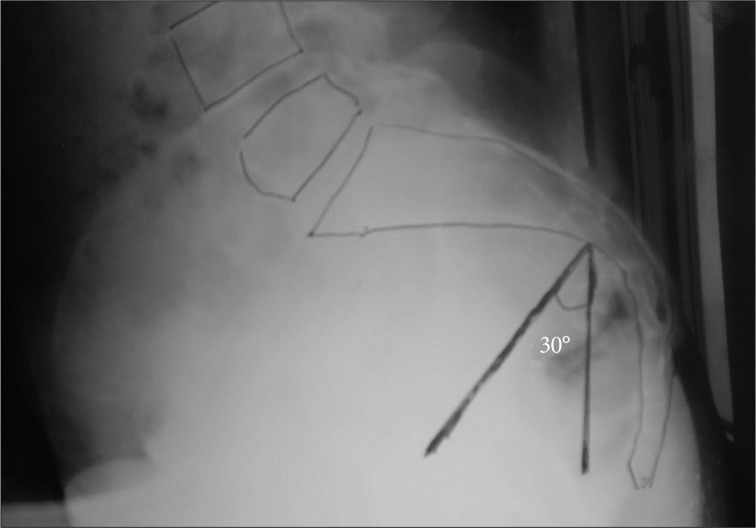J Korean Neurosurg Soc.
2012 Nov;52(5):447-451. 10.3340/jkns.2012.52.5.447.
Introducing a New Risk Factor for Lumbar Disc Herniation in Females : Vertical Angle of the Sacral Curvature
- Affiliations
-
- 1Department of Neurosurgery, Recep Tayyip Erdogan University Medical Faculty, Rize, Turkey. ayhankanat@yahoo.com
- 2Department of Neurosurgery, Karadeniz Technical University Medical Faculty, Trabzon, Turkey.
- 3Department of Anestesiology, Sar Hospital, Rize, Turkey.
- 4Department of Neurosurgery, Samsun Education and Research Hospital, Samsun, Turkey.
- KMID: 2018250
- DOI: http://doi.org/10.3340/jkns.2012.52.5.447
Abstract
OBJECTIVE
To characterize the importance of the vertical angle of the sacral curvature (VASC) in lumbar disc herniations.
METHODS
Morphological data derived from lumbar sagittal MRI imaging. The statistical significance of the findings are discussed. The angles of 60 female patients with lumbar disc herniations (LDH) were compared with the 34 female patients without LDH.
RESULTS
128 of the 185 patients met our inclusion criteria. The vertical angle of sacral curvature is statistically significantly bigger in females with lumbar disc herniations when compared to subjects in control group, 28.32 and 25.4, respectively. (p=0.034<0.05). Same difference was not seen in males.
CONCLUSION
The vertical angle of sagittal sacral curvature may be another risk factor in females with lumbar disc herniations.
MeSH Terms
Figure
Reference
-
1. Abitbol MM. Sacral curvature and supine posture. Am J Phys Anthropol. 1989; 80:379–389. PMID: 2589477.
Article2. Akgun B, Kaplan M, Arici L, Pusat S, Erol FS. Low back pain and sciatica related with the premenstrual period in patients with lumbar disc herniation. Turk Neurosurg. 2010; 20:437–441. PMID: 20963691.3. Aydin V, Aydin S. Outcome measurement after lumbar disc surgery. Turk Neurosurg. 2005; 15:4–11.4. Choi KC, Kim JS, Jung B, Lee SH. Dynamic lumbar spinal stenosis : the usefulness of axial loaded MRI in preoperative evaluation. J Korean Neurosurg Soc. 2009; 46:265–268. PMID: 19844630.
Article5. Cosan TE, Adapinar B, Aslantas A, Tel E, Sahin F. Is Lumbar Spinal Reserve Capacity on CT-Myelography Significant? Turk Neurosurg. 1998; 8:114–118.6. Davies JW. Man's assumption of the erect posture, its effect on the position of the pelvis. Am J Obstet Gynecol. 1955; 70:1012–1021. PMID: 13258687.7. Ergün T, Lakadamyalı H, Sahin MS. The relation between sagittal morphology of the lumbosacral spine and the degree of lumbar intervertebral disc degeneration. Acta Orthop Traumatol Turc. 2010; 44:293–299. PMID: 21252606.
Article8. Gregory WK. The upright posture of man : a review of its origin and evolution. Proc Am Phylos Soc. 1928; 67:339–377.9. Hutchinson PJ, Laing RJ, Waran V, Hutchinson E, Hollingworth W. Assessing outcome in lumbar disc surgery using patient completed measures. Br J Neurosurg. 2000; 14:195–199. PMID: 10912194.
Article10. Kanat A, Epstein CR. Challenges to neurosurgical professionalism. Clin Neurol Neurosurg. 2010; 112:839–843. PMID: 20708840.
Article11. Kanat A, Yazar U, Kazdal H, Yilmaz A, Musluman M. Neurosurgery is a profession. Neurol Neurochir Pol. 2009; 43:286–288. PMID: 19618312.12. Kaner T, Tutkan I. Monoradiculopathy and secondary segmental instability caused by postoperative pars interarticularis fracture : a case report. Turk Neurosurg. 2009; 19:177–181. PMID: 19431131.13. Kara B, Başkurt Z, Acar U. One year outcome after surgery for lumbar disc herniation : a comparison of reoperated and not reoperated patients. Turk Neurosurg. 2007; 17:1–6. PMID: 17918670.14. Keith A. Men's posture : its evolution and disorders. Theories concerning the evolution of men's posture. Br Med J. 1923; 1:451–455. PMID: 20771052.15. Lazennec JY, Ramaré S, Arafati N, Laudet CG, Gorin M, Roger B, et al. Sagittal alignment in lumbosacral fusion : relations between radiological parameters and pain. Eur Spine J. 2000; 9:47–55. PMID: 10766077.
Article16. Legaye J, Duval-Beaupère G, Hecquet J, Marty C. Pelvic incidence : a fundamental pelvic parameter for three-dimensional regulation of spinal sagittal curves. Eur Spine J. 1998; 7:99–103. PMID: 9629932.
Article17. Nachemson A, Zdeblick TA, O'Brien JP. Lumbar disc disease with discogenic pain. What surgical treatment is most effective? Spine (Phila Pa 1976). 1996; 21:1835–1838. PMID: 8855471.18. Naderi S, Egemen N, Gokalp H, Cu1cuoglu A, Erdogan A, Baskaya M. The value of dermatomal somatosensory-evoked potantial in evaluation of herniated lumbar disc. Turk Neurosurg. 1992; 2:139–143.19. Roaf R. Vertebral growth and its mechanical control. J Bone Joint Surg Br. 1960; 42:40–59. PMID: 13854527.
Article20. Rosenfeld R, Livne D, Nevo O, Dayan L, Milloul V, Lavi S, et al. Hormonal and volume dysregulation in women with premenstrual syndrome. Hypertension. 2008; 51:1225–1230. PMID: 18259015.
Article21. Ryu SJ, Kim IS. Spontaneous regression of a large lumbar disc extrusion. J Korean Neurosurg Soc. 2010; 48:285–287. PMID: 21082061.
Article22. Sasani M, Oktenoğlu T, Tuncay K, Canbulat N, Carilli S, Ozer FA. Total disc replacement in the treatment of lumbar discogenic pain with disc herniation : a prospective clinical study. Turk Neurosurg. 2009; 19:127–134. PMID: 19431121.23. Seong JH, Lee JW, Kwon KY, Rhee JJ, Hur JW, Lee HK. Comparative study of posterior lumbar interbody fusion via unilateral and bilateral approaches in patients with unilateral leg symptoms. J Korean Neurosurg Soc. 2011; 50:363–369. PMID: 22200020.
Article
- Full Text Links
- Actions
-
Cited
- CITED
-
- Close
- Share
- Similar articles
-
- The Relationship between Lumbar Shape and Lumbar Disc Herniation
- A Study on the Changes in the Lumbar Lordosis, Lumbosacral and Sacral Inclination Angle during Aging
- Sacral Perineural Cyst with Lumbar Disc Herniation: A Case Report
- Rapid Repeated Recurrent Lumbar Disc Herniation after Microscopic Discectomies
- The Relationship between the Lower Lumbar Disc Herniation and the Morphology of the Iliolumbar Ligaments Using Magnetic Resonance Imaging



